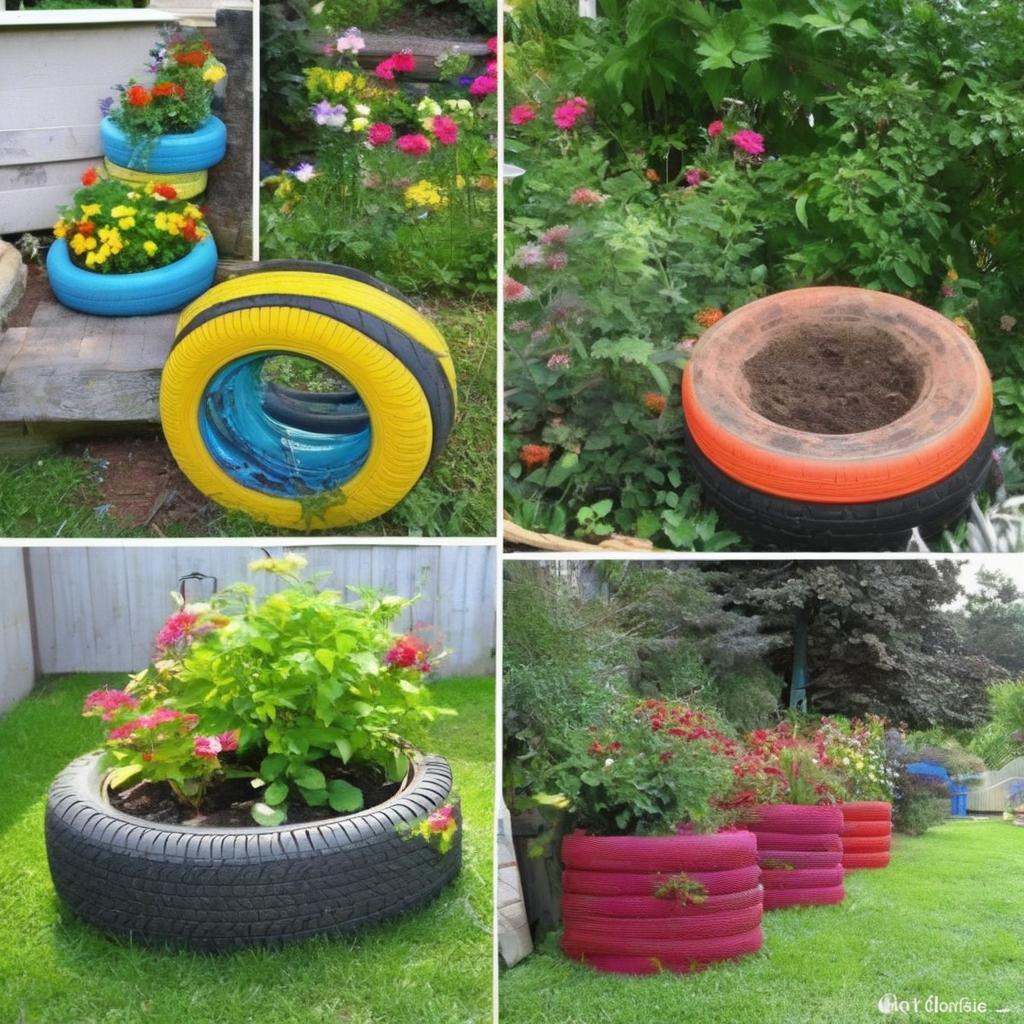
Gardening with Recycled Tires: A Creative and Sustainable Approach
The Americans keep on rolling, and tires keep on wearing out. Every year, there is almost one scrap tire created for every man, woman, and child in the United States. In 2001 alone, Americans discarded nearly 281 million tires, weighing some 5.7 million tons. All of those old treads can provide a lot of good growing space, and were just the folks to put them to use.
The Safety of Using Recycled Tires
There is no appreciable risk in using recycled tires in the vegetable garden. While it is a fact that rubber tires do contain minute amounts of certain heavy metals, the compounds are tightly bonded within the actual rubber compound and do not leach into the soil. One of the ingredients in the rubber recipe is zinc. Zinc, in fact, is an essential plant element. I also expect that rubber is safer to use than treated lumber that contains copper and arsenic.
Benefits of Gardening with Recycled Tires
Tires are durable. The very qualities that make them an environmental headache make them perfect for our uses in the garden. Once they are in place, they won’t rot and will likely be there for your grandchildren to use. Gardening with recycled tires has many benefits besides those directly with the garden itself. It puts to use an article that might otherwise end up in a landfill or other disposal site. Those of us who are into growing our own are often on the lookout for ways to increase production with a minimum of effort.
Ways to Use Old Tires in Gardening
Gardening with tires presents several good ways to do just that, while at the same time helping to recycle the old treads from our automobiles and other wheeled conveyances. Here are some ways to use old tires in gardening:
- A rubberized hotbed
- Raising the roots
- In the greenhouse
- Jump start your tomatoes
- Tire compost bin
- Potato stacks
- Great walls of tires
- All-terrain planters
- Tiers of tires
A Rubberized Hotbed
One of the easiest and earliest ways to get those first salad greens growing is to use an old method that has been common practice around these parts for generations. Folks around here often get those first salad greens going in a planter made from an old tire. For my own planter, I utilized the old tread from a log skidder to give me plenty of size and depth.
How to Create a Rubberized Hotbed
For a project of this type, I’d recommend a fairly large one, such as a rear tire off of a farm tractor or from a log skidder like I used. After laying the tire at the spot where I wanted it, I used a utility knife to cut the sidewall completely out of the upper side. This was fairly easy to do, and nearly doubled the planting area available.
- Fill the tire with some good compost on top of a six-inch layer of fresh manure and seeded my lettuce and spinach.
- The heat generated by the manure’s decomposition helped to heat the seedbed from below.
- The whole thing was covered with some old storm windows obtained for the purpose by some creative scrounging.
- The result was a fine durable hot bed and the only cost involved was for the seed.
Raising the Roots
One of the best ways to grow vegetables, especially in cool climates, is to grow them in raised beds. Let’s look at some of the benefits of raised bed gardening and how the method is a great way to use old tires.
Benefits of Raised Bed Gardening
- When the soil is elevated, it warms faster.
- Raised bed gardens can increase spring soil temperatures by 8 to 13 F over the adjacent soil temperatures at ground level.
- The black, heat-absorbing tires compound the warming effect.
- It dries out more quickly.
- The soil is more exposed, and sun and wind help to dry and warm the soil more quickly.
- It provides deeper soil for root crops to develop.
- You can plant earlier in the season and get your plants off to a healthier and earlier start.
In the Greenhouse
Here is one way we have used tires in our own small greenhouse. Along the front wall, we placed short stacks of tires and filled them with sand. The dark color of the tires serves to absorb heat, and the sand contained in each stack helps to store it.
Using Tires in the Greenhouse
Atop each stack was placed another tire with the upper sidewall removed as already described. The top tire was then filled with compost and soil and then seeded in lettuce, spinach, or whatever. We’ve also found that, in the greenhouse, they make a fine planter for an extra-early or late tomato plant.
Jump Start Your Tomatoes
By the same token, you can get a jump on the spring growing season by creating a mini-greenhouse, of sorts, for a few tomato plants. Once you have a stack or two of tires in place, set your tomato plants in each stack.
How to Create a Mini-Greenhouse
- Next, place a wire hoop or tomato cage in place around the plant.
- Cover the cage with clear plastic and secure it with duct tape, twine, etc.
- If you have them available, you can place an old windowpane over the top of this tomato tower.
- The combination of the black rubber tires and the clear plastic greenhouse will cause the plant to grow quickly.
Tire Compost Bin
Used tires can also be made into a good compost bin. Begin with a half dozen or so tires as large as you can handle. Large truck tires work well.
How to Create a Tire Compost Bin
- Cut the sidewalls out of both sides using the sharp utility knife.
- You will end up with rubber rings of tire treads.
- After you have several of the hoops made, place one on the spot where you want your bin to be located.
- As you fill the first tire hoop, merely place another atop it and fill it.
Potato Stacks
If you are limited in space, then this method is especially beneficial. You can grow a nice crop of spuds in just a few tires.
How to Create a Potato Stack
- Use a utility knife to cut the sidewall completely out of the upper side.
- To begin, pick a spot that is out of the way and perhaps out of sight where you can stack your tires.
- Loosen the soil just enough to allow for some drainage and place the first tire.
- Fill it with soil, being sure to fill the inside of the tire casing as well.
Great Walls of Tires
Tires can even be used to create retaining walls to stabilize an earth bank. When using them for this purpose, begin by laying a level course of tires.
How to Create a Retaining Wall
- Fill these tires completely with sand, soil, or gravel.
- Try to eliminate any holes or pockets in the tires that might provide a haven to vermin like mice or rats.
- Atop the first course of filled tires, add another row, positioning them one-quarter to one-third of the way back on the first course.
- This will give the wall some slope and add stability.
All-Terrain Planters
Try using old tires from riding mowers and all-terrain vehicles (ATVs) for planters. They can be used right on the deck, porch, or patio and can hold plants such as cherry tomatoes, peppers, flowers, herbs, and other compact plants.
How to Create an All-Terrain Planter
- Take one of the tires and cut the sidewall as described for the hotbed.
- Using a drill, bore three holes around the open end of the bowl.
- Space the holes equally around the rim and drill them about a half-inch from the top edge.
- Using three pieces of workable wire about 26 to 28 inches long, attach one wire in each of the three holes.
Tiers of Tires
Another nifty planter for small spaces can be made by stacking four tires of different sizes into a sort of pyramid.
How to Create a Tiered Planter
- Begin with one each of the following sized tires: a farm tractor tire, a tire from a large truck, an automobile tire, and an ATV tire.
- Cut the sidewall out of each.
- Place the tractor tire where you want it and fill it with soil.
- Position the next largest tire, the truck tire, evenly atop the tractor tire.
More Uses for Old Tires
If your place is a bit larger than just a plot and garden, you may find more uses for old tires.
- Use single rows of tires and use mulch or gravel between rows.
- You will have easy access to all sides of your plants and will keep weeding to a minimum.
- Set blackberries, raspberries, and other brambles out in rows of tires-one plant to a tire.
- They will benefit from the same raised bed principle and will be easier to prune back and to mulch.
Commercial Gardening with Tires
With a serious rubberized garden, it would be possible to supply every restaurant and grocery store for miles around. Organically grown fresh garden vegetables are always in demand.
Benefits of Commercial Gardening with Tires
- If you go big and create a growing patch of 50 to 100 tires, you can produce hundreds of pounds of vegetables and some good income.
- For example, with tomatoes selling for 50 cents a pound or more, you can make good money from your tired tomato patch.
- Starting them in the tires will help you to get them to marketable size earlier than other locally grown competition.
Conclusion
Using old tires is a great way to recycle. It’s also a wonderful way to make the most of a small garden plot and generally increase your garden yield. Try some of these ideas, and I’m certain you’ll see good results. Q: Is it safe to use recycled tires in a vegetable garden?
Q: Is it safe to use recycled tires in a vegetable garden?
*Yes, there is no appreciable risk in using recycled tires in the vegetable garden.*
Q: What are the benefits of gardening with recycled tires?
*Gardening with recycled tires has many benefits, including putting to use an article that might otherwise end up in a landfill or other disposal site, and providing a durable and long-lasting planter.*
Q: How do I create a rubberized hotbed using old tires?
*To create a rubberized hotbed, cut the sidewall out of a large tire, fill it with compost and manure, and cover it with old storm windows.*
Q: What are the benefits of raised bed gardening with tires?
*The benefits of raised bed gardening with tires include warmer soil, improved drainage, and deeper soil for root crops to develop.*
Q: How do I create a tire compost bin?
*To create a tire compost bin, cut the sidewalls out of several large tires, stack them on top of each other, and fill them with compost materials.*
Q: Can I use old tires to grow potatoes?
*Yes, you can use old tires to grow potatoes by stacking them and filling them with soil.*
Q: How do I create a retaining wall using old tires?
*To create a retaining wall, lay a level course of tires, fill them with sand or soil, and add additional rows of tires, positioning them one-quarter to one-third of the way back on the first course.*
Q: What are some other uses for old tires in gardening?
*Other uses for old tires in gardening include creating planters, mulch or gravel pathways, and supports for brambles.*
Q: Can I use old tires for commercial gardening?
*Yes, you can use old tires for commercial gardening, and with a large enough patch, you can produce hundreds of pounds of vegetables and generate a good income.*













